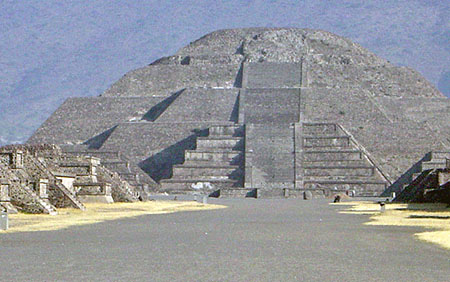HIS 111
Unit 6: Mesoamerica

Pyramid of the
Moon, part of the complex at Teotihuacan, near Mexico City, abandoned
in the eighth century ce. See some additional photos and then have a look at the excellent website on Teotihuacan, The City of the Gods. I also have some photos of Inca civilization.
 What you
must do in this unit
What you can do in this unit
Some videos that you can watch for this unit
Extra Credit Options
What you
must do in this unit
What you can do in this unit
Some videos that you can watch for this unit
Extra Credit Options
- Take the short 5-point quizzes for chapters 5 and 18. Log into Blackboard and look under "Chapter Quizzes." You have five minutes to complete each quiz (multiple-choice questions).
- The Popol Vuh is the sacred book of the Quiché Indians,
who are descended from Maya in present-day Guatemala. The book, recorded in the sixteenth century in
Quiché in Latin script and translated in the nineteenth century, is the Mayan creation myth that had been handed
down for thousands of years and reflects early Mesoamerican mythology. In many ways, the epic resembles
Genesis of the Judaeo-Christian tradition. For extra
credit, in a one-page paper for a maximum of 50 points, consider a comparison of the Popol Vuh
with Genesis. (There is also a version
at www.jaguar-sun.com/popolvuh.html, and there is a new website, sponsored by Ohio State University, with versions of the PV in three different languages.) There are also complete versions of Genesis available online.
- For a maximum of 25 points extra credit, read Hernan Cortés
Second Letter to Charles V, 1520, and in a long paragraph, explain what scholars can learn about Indian society from this account.
- For a maximum of 25 points extra credit, read Pedro de Cieza de Léon
Chronicles of the Incas,
1540, and in a long paragraph, explain what scholars can learn about the Inca economy from this short excerpt.
- For extra credit, please suggest a
relevant website for this unit of the course. Send the title of the site, the url and a
brief explanation why you find the information interesting and applicable to
the material being studied this unit.
|

